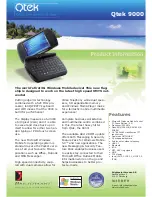
PT630 Operation Guide
Page 12 of 41
______________________________________________________
User Mode Commands:
Command Usage
RUN
Runs the selected executable program
TER
Terminal emulation mode or Form Caching operation
COM
Kermit server mode
DIR
Display RAM disk file directory
ERA
Delete a file from RAM disk
TYP
Dump the content of a file to the LCD
CPY
Copy data from a device/file to another device/file
SET
Set real time clock, scanner type and power-on logo
3.2.2.1 RUN
After a program is downloaded to the hand held unit, the user may invoke the
RUN command and press [
→
] key to display the executable files stored in
memory, then press [ENT] to run the program. Pressing
[CMD]
then
[Alpha]
and then pressing any key will return the PT630 to the User Mode menu.
< RUN PROGRAM >
Filename:
NULL
3.2.2.2 TER
The
TER
command puts the PT630 in either Terminal Emulation operation or FormCaching
operation. User will need to choose when the TER was selected and the PT630 execute the operation.
Terminal Emulation Operation.
When EXEC transfers control to this EPROM-resident
application program, the PT630 operates as a dumb ASCII terminal while exchanging data with a
Host computer. Data input from scanning bar code labels or key-press will be sent to the portable
terminal RS-232 port. In order to carry out a successful file transfer, communication parameter
setting such as baud rate, data bits, parity, stop bits and flow control, must match the setting at the
Host end. Data received from the serial port is displayed on the LCD screen.
The functionality of the PT630 in terminal mode depends on the format configured in the Terminal
Control Table. The PT630 is either configured as free format processing or forms based processing.
The PT630 examines the "data buffer" and determines if host data transfer is required. If a
terminating condition exists by the reception of a terminating character, the PT630 outputs the buffer
to its RS232 port. Data transfer between the host machine and the PT630 is primarily controlled by
the terminating conditions specified in the Terminal Control Table.
In the terminal application, the program further distinguishes the character mode communication
from block mode communication. Character mode communication dictates that the PT630 sends
every key (one at a time) to the host. Normally character mode communication uses None protocol,
otherwise there will be an overwhelming protocol overhead. The input character may come from the
keypad or barcode scanner, whichever comes first. Data characters sent over from the host system
































